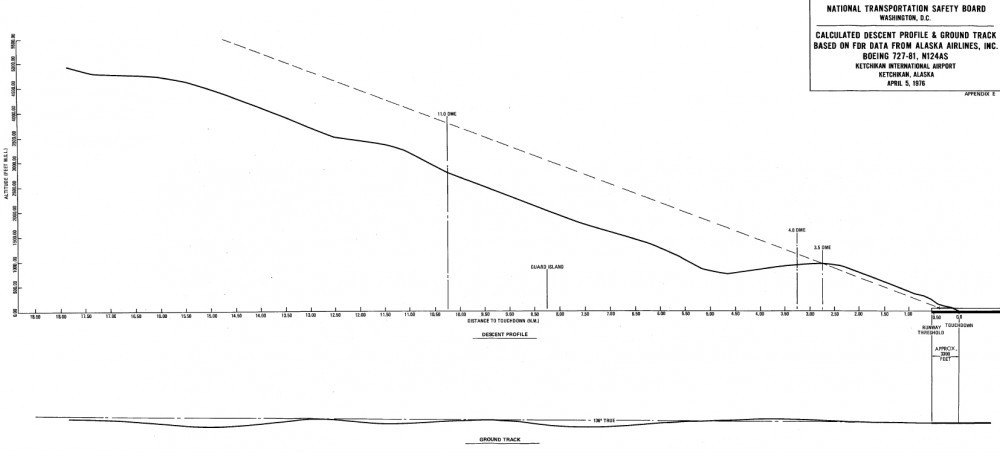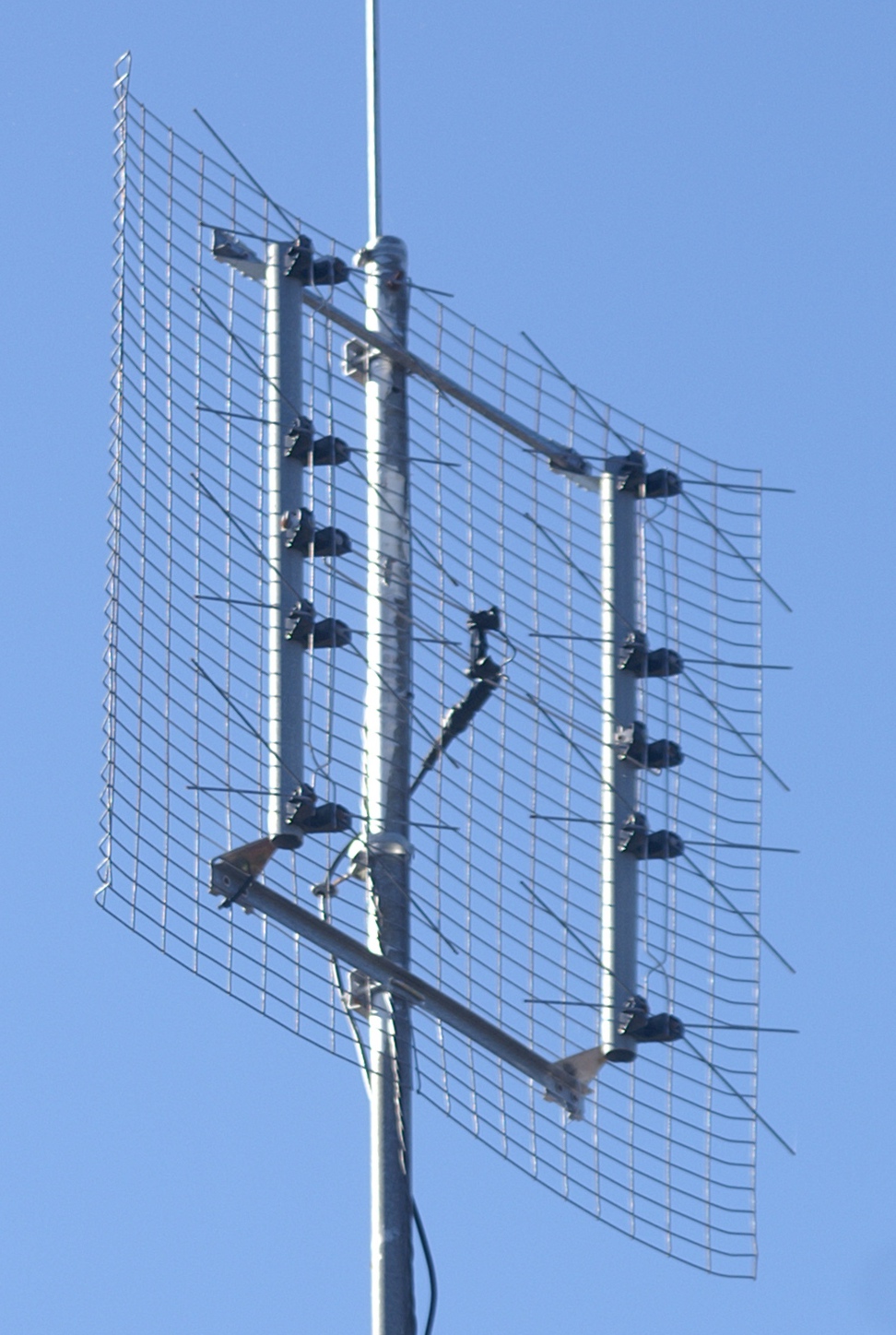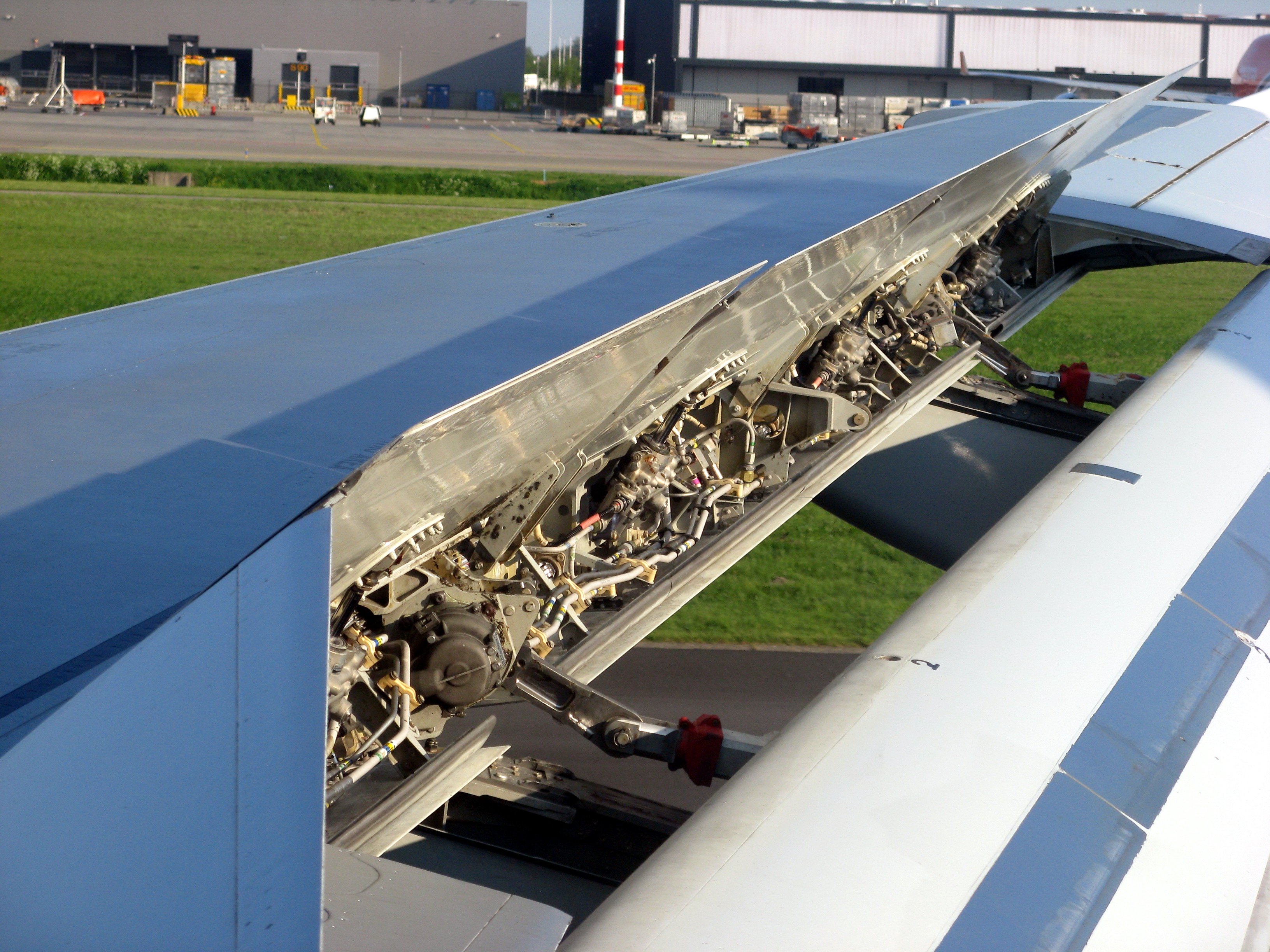|
Alaska Airlines Flight 60
The crash of Alaska Airlines Flight 60 was an accident involving a Boeing 727-81 of the American airline Alaska Airlines at Ketchikan International Airport in Ketchikan, Alaska, United States, on April 5, 1976, resulting in the death of a passenger with 32 serious and 17 minor injured survivors among the initial 50 passengers and crew on board. Crew On its final journey, Flight 60 was under the command of 55-year-old captain Richard L. Burke, who had a total of 19,813 hours of flight experience, including 2,140 hours on the Boeing 727 and had been in service with Alaska Airlines since 1960, while 42-year-old co-pilot Richard Bishop had a total of 3,193 total flight hours of experience, including 1,980 hours on the Boeing 727 and had been in service with Alaska Airlines since 1966. 43-year-old Second officer Huston Leach was employed by Alaska Airlines in the same year as co-pilot Bishop, had accumulated 3,454 total flight hours, including 2,641 hours on the Boeing 727. A ... [...More Info...] [...Related Items...] OR: [Wikipedia] [Google] [Baidu] |
Runway Excursion
A runway excursion is a runway safety incident where an aircraft makes an inappropriate exit from the runway. Runway excursions include runway overruns, where an aircraft is unable to stop before it reaches the end of the runway. Runway excursions can happen because of pilot error, poor weather, or a fault with the aircraft. According to the Flight Safety Foundation, as of 2008, runway excursions were the most frequent type of landing accident, slightly ahead of runway incursion. For runway accidents recorded between 1995 and 2007, 96% of runway accidents and 80% of accidents with fatalities involved runway excursions. Management and prevention Efforts to address runway excursion either focus on preventing runway excursions, or on minimizing the amount of damage or injury caused by a runway excursion. In the latter category, aviation safety regulators may establish standards such as minimum runway safety areas intended to allow adequate time and distance for an aircraft to stop ... [...More Info...] [...Related Items...] OR: [Wikipedia] [Google] [Baidu] |
Layover
250px, Layover for buses at LACMTA's Warner Center Transit Hub, Los Angeles ">Los_Angeles.html" ;"title="Warner Center Transit Hub, Los Angeles">Warner Center Transit Hub, Los Angeles In scheduled transportation, a layover (also waypoint, way station, or connection) is a point where a vehicle stops, with passengers possibly changing vehicles. In public transit, this typically takes a few minutes at a trip terminal. For air travel, where layovers are longer, passengers will exit the vehicle and wait in the terminal, often to board another vehicle traveling elsewhere. A stopover is a longer form of layover, allowing time to leave the transport system for sightseeing or overnight accommodation. History Historically, a way station was a facility for resting or changing a team of horses drawing a stagecoach. Typically a simple meal was available to passengers, who were also able to use Public toilet, restrooms. Basic overnight accommodations were sometimes available in remote ins ... [...More Info...] [...Related Items...] OR: [Wikipedia] [Google] [Baidu] |
Antenna Array
An antenna array (or array antenna) is a set of multiple connected antennas which work together as a single antenna, to transmit or receive radio waves. The individual antennas (called ''elements'') are usually connected to a single receiver or transmitter by feedlines that feed the power to the elements in a specific phase relationship. The radio waves radiated by each individual antenna combine and superpose, adding together ( interfering constructively) to enhance the power radiated in desired directions, and cancelling ( interfering destructively) to reduce the power radiated in other directions. Similarly, when used for receiving, the separate radio frequency currents from the individual antennas combine in the receiver with the correct phase relationship to enhance signals received from the desired directions and cancel signals from undesired directions. More sophisticated array antennas may have multiple transmitter or receiver modules, each connected to a separate a ... [...More Info...] [...Related Items...] OR: [Wikipedia] [Google] [Baidu] |
Frontage Road
A frontage road (also known as an access road, outer road, service road, feeder road, or parallel road) is a local road running parallel to a higher-speed, limited-access road. A frontage road is often used to provide access to private driveways, shops, houses, industries or farms. Where parallel high-speed roads are provided as part of a major highway, these are also known as local-express lanes. A frontage lane is a paved path that is used for the transportation and travel from one street to another. Frontage lanes, closely related to a frontage road, are common in metropolitan areas and in small rural towns. Frontage lanes are technically not classified as roads due to their purpose as a bridge from one road to another, and due to the architectural standards that they are not as wide as a standard road, or used as commonly as a standard road, street, or avenue. Overview Frontage roads provide access to homes and businesses which would otherwise be cut off by a limited ... [...More Info...] [...Related Items...] OR: [Wikipedia] [Google] [Baidu] |
Gully
A gully is a landform created by running water, mass movement, or commonly a combination of both eroding sharply into soil or other relatively erodible material, typically on a hillside or in river floodplains or terraces. Gullies resemble large ditches or small valleys, but are metres to tens of metres in depth and width and are characterised by a distinct 'headscarp' or 'headwall' and progress by headward (i.e. upstream) erosion. Gullies are commonly related to intermittent or ephemeral water flow usually associated with localised intense or protracted rainfall events, or snowmelt. Gullies can be formed and accelerated by cultivation practices on hillslopes (often gentle gradient) in farmland, and they can develop rapidly in rangelands from existing natural erosion forms subject to vegetative cover removal and livestock activity. Etymology The earliest known usage of the term is from 1657. It originates from the French word ''goulet'', a diminutive form of ''goule'' which m ... [...More Info...] [...Related Items...] OR: [Wikipedia] [Google] [Baidu] |
Takeoff
Takeoff is the phase of flight in which an aerospace vehicle leaves the ground and becomes airborne. For aircraft traveling vertically, this is known as liftoff. For aircraft that take off horizontally, this usually involves starting with a transition from moving along the ground on a runway. For balloons, helicopters and some specialized fixed-wing aircraft (VTOL aircraft such as the Harrier and the Bell Boeing V22 Osprey), no runway is needed. Horizontal Power settings For light aircraft, usually full power is used during takeoff. Large transport category (airliner) aircraft may use a reduced power for takeoff, where less than full power is applied in order to prolong engine life, reduce maintenance costs and reduce noise emissions. In some emergency cases, the power used can then be increased to increase the aircraft's performance. Before takeoff, the engines, particularly piston engines, are routinely run up at high power to check for engine-related problems. The airc ... [...More Info...] [...Related Items...] OR: [Wikipedia] [Google] [Baidu] |
Thrust Reversal
Thrust reversal, also called reverse thrust, is the temporary diversion of an aircraft engine's thrust for it to act against the forward travel of the aircraft, providing deceleration. Thrust reverser systems are featured on many jet aircraft to help slow down just after touch-down, reducing wear on the brakes and enabling shorter landing distances. Such devices affect the aircraft significantly and are considered important for safe operations by airlines. There have been accidents involving thrust reversal systems, including fatal ones. Reverse thrust is also available on many propeller-driven aircraft through reversing the controllable-pitch propellers to a negative angle. The equivalent concept for a ship is called astern propulsion. Principle and uses A landing roll consists of touchdown, bringing the aircraft to taxi speed, and eventually to a complete stop. However, most commercial jet engines continue to produce thrust in the forward direction, even when idle, actin ... [...More Info...] [...Related Items...] OR: [Wikipedia] [Google] [Baidu] |
Flap (aeronautics)
A flap is a high-lift device used to reduce the stall (flight), stalling speed of an aircraft wing at a given weight. Flaps are usually mounted on the wing trailing edges of a fixed-wing aircraft. Flaps are used to reduce the take-off distance and the landing distance. Flaps also cause an increase in Drag (physics), drag so they are retracted when not needed. The flaps installed on most aircraft are partial-span flaps; spanwise from near the wing root to the inboard end of the ailerons. When partial-span flaps are extended they alter the spanwise lift distribution on the wing by causing the inboard half of the wing to supply an increased proportion of the lift, and the outboard half to supply a reduced proportion of the lift. Reducing the proportion of the lift supplied by the outboard half of the wing is accompanied by a reduction in the angle of attack on the outboard half. This is beneficial because it increases the margin above the Stall (fluid dynamics), stall of the outboa ... [...More Info...] [...Related Items...] OR: [Wikipedia] [Google] [Baidu] |
Go-around
In aviation, a go-around is an aborted landing of an aircraft that is on final approach or has already touched down. A go-around can either be initiated by the pilot flying or requested by air traffic control for various reasons, such as an unstabilized approach or an obstruction on the runway. Etymology The term arises from the traditional use of traffic patterns at airfields. A landing aircraft will first join the traffic pattern/circuit and prepare for landing. If for some reason, the pilot decides not to land, the pilot can simply fly back up to traffic pattern altitude/circuit height, and complete another circuit. The term "go-around" is still used even for modern airliners, though they may not use traditional traffic patterns/circuits for landing. Reasons for use Initiation of a go-around may be either ordered by air traffic control (normally the local or tower controller in a controlled field) or initiated by the pilot in command of the aircraft. In naval aviation, t ... [...More Info...] [...Related Items...] OR: [Wikipedia] [Google] [Baidu] |
Spoiler (aeronautics)
In aeronautics, a spoiler (sometimes called a lift spoiler or lift dumper) is a device which intentionally reduces the lift (force), lift component of an airfoil in a controlled way. Most often, spoilers are plates on the top surface of a wing that can be extended upward into the airflow to ''spoil'' the streamline flow. By so doing, the spoiler creates a controlled Stall (flight), stall over the portion of the wing behind it, greatly reducing the lift of that wing section. Spoilers differ from air brake (aeronautics), airbrakes in that airbrakes are designed to increase drag without disrupting the lift distribution across the wing span, while spoilers disrupt the lift distribution as well as increasing drag. Spoilers fall into two categories: those that are deployed at controlled angles during flight to increase descent rate or control roll, and those that are fully deployed immediately on landing to greatly reduce lift ("lift dumpers") and increase drag. In modern fly-by- ... [...More Info...] [...Related Items...] OR: [Wikipedia] [Google] [Baidu] |
Alaska Airlines Flight 60 Route
Alaska ( ; russian: Аляска, Alyaska; ale, Alax̂sxax̂; ; ems, Alas'kaaq; Yup'ik: ''Alaskaq''; tli, Anáaski) is a state located in the Western United States on the northwest extremity of North America. A semi-exclave of the U.S., it borders the Canadian province of British Columbia and the Yukon territory to the east; it also shares a maritime border with the Russian Federation's Chukotka Autonomous Okrug to the west, just across the Bering Strait. To the north are the Chukchi and Beaufort Seas of the Arctic Ocean, while the Pacific Ocean lies to the south and southwest. Alaska is by far the largest U.S. state by area, comprising more total area than the next three largest states (Texas, California, and Montana) combined. It represents the seventh-largest subnational division in the world. It is the third-least populous and the most sparsely populated state, but by far the continent's most populous territory located mostly north of the 60th parallel, wi ... [...More Info...] [...Related Items...] OR: [Wikipedia] [Google] [Baidu] |
Visual Approach
A visual approach is an approach to a runway at an airport conducted under instrument flight rules (IFR) but where the pilot proceeds by visual reference and clear of clouds to the airport. The pilot must at all times have either the airport or the preceding aircraft in sight. This approach must be authorized and under the control of the appropriate air traffic control (ATC) facility. The International Civil Aviation Organization (ICAO) definition adds that the visual approach can commence when "either part or all of an instrument approach is not completed", varying only slightly from the Federal Aviation Administration regulation and is essentially identical. Purpose The visual approach allows a pilot to fly to the runway without having to perform an instrument approach. This can greatly reduce pilot and controller workload, and expedite traffic by shortening flight paths to the airport. Taking a shorter route to the airport in lieu of flying a complicated instrument appro ... [...More Info...] [...Related Items...] OR: [Wikipedia] [Google] [Baidu] |






.jpg)



